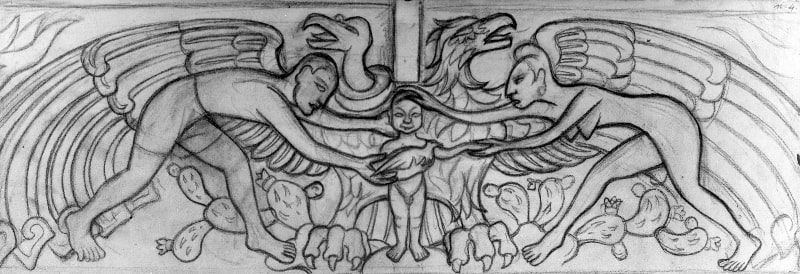Mural: The University, the family, and sports in Mexico by Diego Rivera
Diego Rivera's iconic high relief mural at the Olímpico Universitario. Learn more about "The University, the family, and sports in Mexico".

When the Olympic University Stadium was finished in 1952 by the architect Augusto Pérez Palacios, in collaboration with his colleagues Jorge Bravo Jiménez and Raúl Salinas Moro, Diego Rivera began to paint his mural in high relief (or sculpture-painting) La Universidad, la familia y el deporte en México ("The University, the family and sports in Mexico") on the main façade of this iconic building in Ciudad Universitaria.
Made with colored stones, in addition to the artist from Guanajuato, 70 workers, masons and stonemasons participated in its creation, as well as 12 painters and architects.
This mural in high relief shows, as in the university coat of arms, an eagle and a condor, but this time wrapping their open wings around a family made up of a Spanish man, an indigenous woman, and a girl holding a dove as a symbol of peace; and below them, a feathered serpent inlaid with corn cobs, representing Quetzalcoatl.
The University, the family, and sports in Mexico are topped at their ends by two athletes: a man (on the left) and a woman (on the right) lighting a torch with the Olympic fire.
"As the University Olympic Stadium is a construction in which modern architecture and the ancestral technique of ancient Mexico were fused, Diego Rivera wanted this mural in high relief to operate from the modern, but with an eye to the ancient.
Moreover, it is an experimental work that emerged from what is known as plastic integration, a movement that sought the articulation of painting, sculpture, and architecture," says Daniel Vargas Parra, professor at the School of Philosophy and Letters and specialist in Art History.

Preparatory drawings
The original project of La Universidad, la familia y el deporte en México ("The University, the family and sports in Mexico") considered the elaboration of a large mural that would cover the entire perimeter slope of the Olympic University Stadium and that would deal with the history of sports in our country, from pre-Hispanic times to contemporary times.
"In Diego Rivera's preparatory drawings it can be seen that the two athletes who are lighting a torch with the Olympic fire were the culmination of a series of figures that were running, one after the other, in a kind of photogram," reports María de Lourdes Cruz González Franco, founder, and coordinator of the Mexican Architects Archive of the Faculty of Architecture.
On the back façade of the Olympic University Stadium or western wall, Diego Rivera planned to depict various aspects of sports in Mesoamerica, including those related to the ball game.
"Throughout his life, Diego Rivera had collected many figures from different pre-Hispanic cultures that he planned to exhibit in the Anahuacalli Museum. So, based on some of them, he drew the sketch of that part of The University, the family, and sports in Mexico. In it he recorded what he understood as the fusion of ancient sport with ritual and war," says Vargas Parra.

In other sections, according to the preparatory drawings, there would be other elements, such as a woman athlete performing a jump, a soccer player and a basketball player, and a group of architects, engineers, and doctors showing the planning of Ciudad Universitaria.
"It should be remembered that, as far as Mexico was concerned, it was the first time that all the specialists joined forces to generate a social architecture project with an educational function, which appealed powerfully to Diego Rivera," adds Vargas Parra.
Irreconcilable differences
At a congress to which they were invited to speak about Ciudad Universitaria, renowned architects such as Frank Lloyd Wright, Walter Gropius, and Richard Neutra enthusiastically praised the plastic integration implemented in the Olympic University Stadium and strongly criticized other buildings, such as the Rectory Tower, the Science Tower and the Faculty of Philosophy and Letters.
More confident than ever, Diego Rivera never tired of repeating in his lectures that these famed architects preferred plastic integration and organic architecture -which promotes harmony between the human habitat and nature- over any other type of architecture.

"This caused irreconcilable theoretical and practical differences to arise between Diego Rivera and architects Mario Pani and Enrique del Moral, who at that time were already in charge of the General Directorate of Works of Ciudad Universitaria, concerning the execution of architecture in our country. Thus, the original project of The University, the Family and Sports in Mexico dragged on until, upset because one of his workers was accused of extracting material from the area, Diego Rivera decided to step aside and leave unfinished what he considered to be his best plastic work," explains Vargas Parra.
With the departure of Diego Rivera, not a few architects felt more comfortable, as they were in favor of the Olympic University Stadium retaining its pure line and not being subjected to that kind of interventions that they called, not without some disdain, "decorative".
According to Cruz González Franco, for historians of art and, in particular, of Diego Rivera's painting, it is a pity that this mural in high relief was left unfinished.
"However, if La Universidad, la familia y el deporte en México had been finished, the Estadio Olímpico Universitario would perhaps have ceased to be an architecturalized crater, as Diego Rivera himself called it, which dialogues with its surroundings. The idea of Pérez Palacios, Bravo Jiménez, and Salinas Moro was to promote a dialogue between the exterior and the interior of this construction, that is to say, that from some points on the outside you could see something of the inside and from the main grandstand you could see the university campus. It is not known if Diego Rivera also planned to use high relief on the other walls. It has been said that he probably would not have given them so much volume so as not to detract from the importance of the central part of the mural. In any case, this work and the stadium constitute an inseparable unit and represent, both for the members of the university community and for the rest of Mexican society, a milestone in our social imaginary," he concludes.




